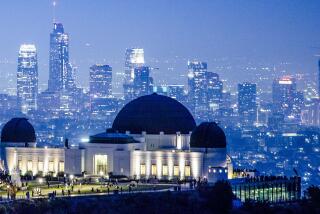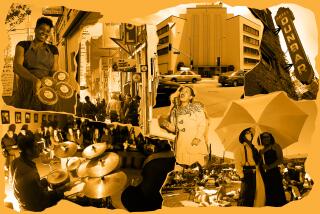Devil of a Story
- Share via
As someone who has been writing about historic Central Avenue for the past dozen years, I’m surprised to read how inaccessible it was for the production designer of “Devil in a Blue Dress,” the new Easy Rawlins film (“The ‘Devil’ Is in the Details,” by Sean Mitchell, June 26).
While I was researching my two books and one detective novel touching on the subject (all published within the past several years), not to mention numerous articles and two dozen R&B; reissue album notes, I found enough photos, old news items and personal recollections to bring Central Avenue very much alive for me. Two other recent chroniclers--Tom Reed and Johnny Otis--also brought “the Stem” into clear focus in their books.
So Central Avenue’s rich history wasn’t lost, really. It’s just that until Hollywood’s new interest made it trendy, the street didn’t merit any media attention.
JIM DAWSON
Hollywood
Your cover story on “Devil in a Blue Dress” included two photos. One was a shot of Central Avenue in the ‘40s, and it clearly shows the L.A. Transit Lines (“Yellow Cars”) narrow-gauge (42-inch) tracks. The bottom picture, from the movie, shows a section of Main Street between “Wilton” and Fifth representing Central Avenue in the late ‘40s; there is no such street alignment, and I believe Winston Street downtown was indicated.
The other puzzle was that the bottom photo shows what appears to be a railroad track between white lines in the center of the street. I say “railroad” because no trolley wires are in sight. This is obviously standard-gauge (56 1/2 inches), but I know of no such track on either Main or Central. Was this track put in by technical movie magic?
In reality, the streetcar line on Central from Slauson north was replaced by a trolley coach on Aug. 3, 1947, but I am sure that the tracks would still have been in the street during 1948, the time of the movie.
HARVEY J. QUITTNER
Los Angeles
Reader Quittner is correct on all counts. The cross street in question is Winston, not Wilton, and the tracks would have remained in 1948. Notes Gary Frutkoff, the film’s production designer: “We re-created the tracks and applied them to the street with permission from the city, and they stayed for 11 days.”
More to Read
Sign up for our Book Club newsletter
Get the latest news, events and more from the Los Angeles Times Book Club, and help us get L.A. reading and talking.
You may occasionally receive promotional content from the Los Angeles Times.










